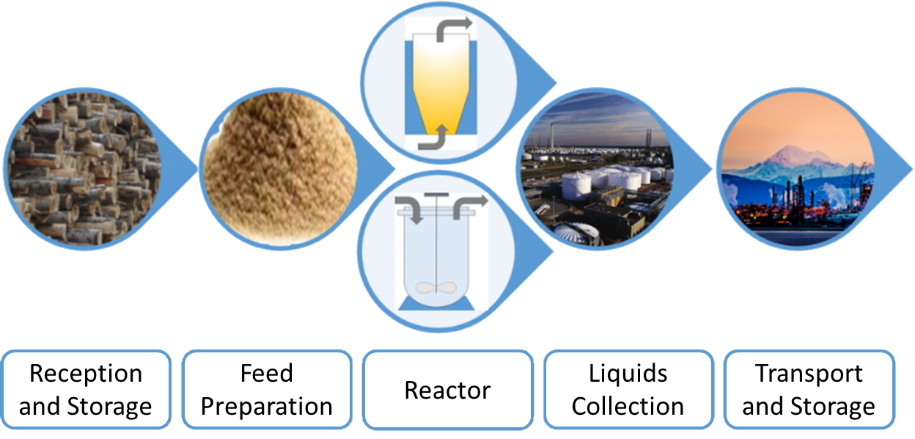Liquefaction System Components
Key Points
- There are different challenges in unit operations for processing Pyrolysis and Solvent Liquefaction
- Solvent liquefaction is often considered for wet feeds, while pyrolysis is for dryer feeds.

Liquefaction System Components
A direct thermochemical liquefaction system consists of an integrated series of unit operations starting with delivery of a regular or opportunity organic, biomass feedstock. Considerations should be made for plant size and mobility, to address the question of whether in a given circumstance it is more cost efficient to transport and store non-densified biomass or use smaller, distributed or mobile liquefaction systems. Once in liquid form, bio-oils and bio-crudes can be more easily handled or transported than raw biomass, but still have challenges. Typical unit operations are described below and some of the different challenges associated with them presented briefly. The use of catalysts will not be addressed in detail here.
Comparison of Typical Unit Operations for Solvent Liquefaction and Pyrolysis
Operation |
Solvent Liquefaction |
Pyrolysis |
| Reception and Storage | For wet feeds: silo storage, container, or pile storage. Considerations for spoilage must be made for wet feeds. For handling, by loader or conveyor or slurry pump depending on wetness of biomass. | Similar to a pulp and paper mill. For dry feeds, pile storage and bulk loaders or conveyors. |
| Feed Preparation | Typically size reduction, solvent addition, slurrying, homogenous catalyst addition. If the biomass will be pumped at high pressure, the resultant slurry must be compatible with pump. Typically 20% solids content is pumpable through cement pumps even though amazingly thick. If biomass is wet, water solvent requirements are low. Slurrying can be performed with size reduction in wet grinders. | Typically drying and size reduction. Drying is essential, to <10% moisture or the bio-oil product can carry too much water. Waste heat from downstream unit operations can be used to dry. Although expensive, size reduction is critical to heat transfer, thus yield and quality of product. Pyrolyzers such as ablative that can use larger particles have less cost in grinding. |
| Reactor | Continuous stirred tank reactor or plug flow reactor. To around 370C and 22MPa, with sufficient heating to put biomass through glass transition temperatures without plugging. | Wide variety of continuous configurations that maximize heat transfer to biomass particle and can remove and quench vapor quickly before it degrades. Considerations depend on the biomass, utilities, and intended product. |
| Char and ash separation | Optimally done at pressure and temperature, as online filtration is easier when the viscosity of the hot bio-crude is lower and when solubility of ash is reduced near the critical point of water. Filtration after the product has been collected is more difficult. Ash may be recycled as nutrients. | Cyclones or other methods primarily remove the char which is where the ash is located. Char is sometimes recycled for heat or as a co-product. Some solids will reach the bio-oil, and may need to be filtered depending on the bio-oil application. |
| Liquids collection | Liquid is collected after cooling and letting down the liquid pressure. Non-condensible gases that are soluble at temperature/pressure can be separated immediately. The bio-oil and aqueous layers will also quickly phase segregate, allowing for recycle of the aqueous solvent to be mixed with new biomass, and storage of the bio-crude. | Collection can be performed using an immiscible quench liquid or recycled bio-oil spray. Collections of aerosols is difficult, yet there has been success with capture devices such as electrostatic precipitators, demisters, and fan impeller blades. Careful design is needed to avoid blockage from differential condensation of heavy oils, such as the transition below 300C, and to prevent loss of water and light oils that help maintain a lower bio-oil viscosity. |
| Storage and transport | Upon cooling to room temperature, the bio-crude may be solid. However, thermal stability is high enough that the material can be easily transferred around 50 to 100C without affecting quality. Depending on the conditions, bio-crude may retain some corrosivity, but long term storage does not appear to affect quality which is advantage over many bio-oils. | Upon cooling to room temperature, most bio-oils are easily pumpable. It is often corrosive or incompatible with some metal or plastic storage. Time and thermal instability may eventually result in higher viscosity, phase separation, and heat release due to polymerization, such that lengthy storage should be mimized. |


